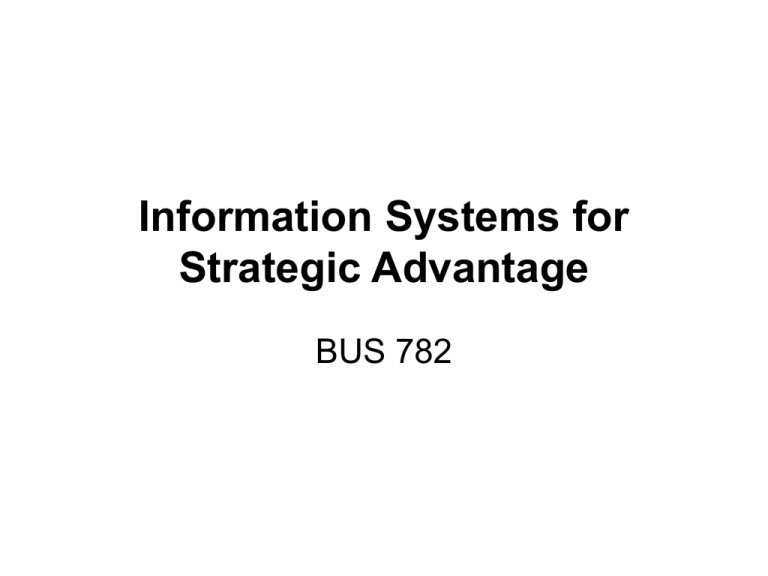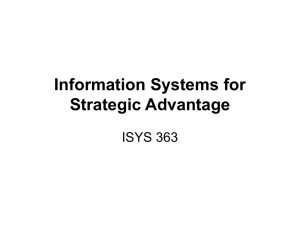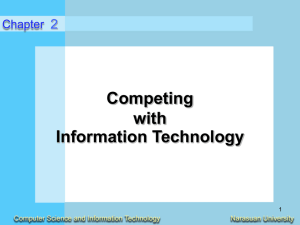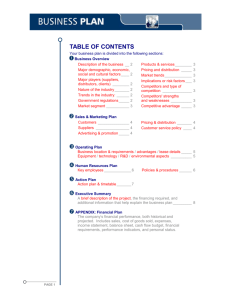Information Systems for Strategic Advantage
advertisement

Information Systems for Strategic Advantage BUS 782 Strategic Information System • Information systems that provide a firm with competitive products and services which give it a strategic advantage over its competitors in the marketplace. – Information systems that promote business innovation, improve operational efficiency. Strategic Advantage and Strategic Necessity • Strategic advantage refers to obtaining a sustainable competitive edge over competitors. The ability to obtain a greater than normal return on investment. • A strategic necessity is a system that must be installed to remain competitive and stay in business. Auction sites • Yahoo, Ebay • Necessity: – Ability to search and view items, view seller info and bid history, place a bid, online payment. • Advantage: – Ebay • Ebay store • PayPal • Micropayments • SkyPe: http://pages.ebay.com/skype/ – Special SkyPe services for eBay sellers and buyers • Amazon Associates: – Amazon.com's affiliate marketing program. By linking to Amazon products and services you can add compelling content for your site visitors enjoyment and receive up to 8.5% in referral fees for doing so. – aStore Being the First • Internet Search Engines: – Yahoo, Google – Teoma – Mooter New Way of Doing Business • Dell: – Customization • America West website -http://www.americawest.com/awa/ • Select your seats • Web check-In (Travel Tools and Services) Comparing Websites • Travel:Yahoo vs Expedia – – – – Hotels Cars Vacations Cruises • Real Estate:Century 21 vs ReMax – – – – Buy: neighborhood, school Sell Finance Learn Competitive forces model by Michael Porter Threat of New Entrants Bargaining Power of Suppliers Rivalry among Existing Competitors Threat of Substitute Products Bargaining Power of Customers Competitive Strategies • Cost leadership strategy: – Become a low cost producer of products and services – Find ways to help suppliers or customers reduce their costs • Product differentiation strategy. • Innovation strategy: Finding new way of doing business, enter new market. • Alliance strategy: Establish alliances with customer, suppliers, competitors, other company. • Growth strategy: expanding, diversifying, integrating. Strategic Roles for Information Systems • Improving business operations • Promoting business innovation • Locking in customers and suppliers – Interorganizational IS, EDI, automatic inventory replenishment system • Creating switching costs – make customers dependent on the continued use of innovative IS. • Raising barriers to entry – discourage competitors from entering a market The Value Chain and Strategic IS • It views a firm as a series, or chain, or network of basic activities that add value to its products and services, and thus add a margin of value to the firm. – Margin is the value of the firm’s products and services less their costs, as perceived by the firm’s customers. • Support activities: – Administration, human resource management ,etc. • Primary activities: – Inbound logistics, operations, outbound logistics, marketing, etc. The Value Chain Administrative Coordination & Support Services Human Resource Management Technology Development Procurement of Resources Inbound Outbound Operations Logistics Logistics Marketing Customer and Service Sales Becoming an Agile Competitor • Agility in competitive performance is the ability of a business to prosper in rapidly changing, continually fragmenting global markets for high-quality, high-performance, customer-configured products and services. An agile company can: – 1. Make a profit in markets with broad product ranges and short model lifetimes – 2. Process orders in arbitrary lot sizes – 3. Offer individualized products while maintaining high volumes of production. IT and Agility • Agile companies depend heavily on information technology to: – 1. Enriched its customers with customized solutions to their needs. • Mass customization – 2. Cooperate with other businesses to bring products to market as rapidly and cost-efficient as possible. – B2B E-Commerce • Electronic Exchange: An electronic forum where manufacturers, suppliers, and competitors buy and sell goods. • Example: WorldWide Retail Exchange (WWRE) IT Doesn’t Matter – Nicholas Carr • The basis for a sustainable competitive advantage is not ubiquity but scarcity. • The core functions of IT have become available to all. • Computer programs today are industry specific, most “right out of box””. That is they are commodities. • Costs of doing business – paid by all but provide distinction to none. Carr’s Rules for Firms • Spend less • Follow, don’t lead • Focus on the risks of IT, not the opportunities: – Webvan - wiki – Peapod





